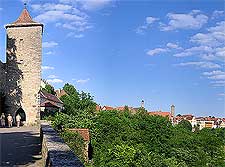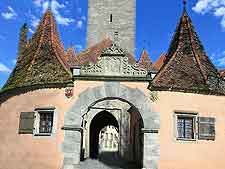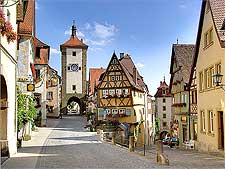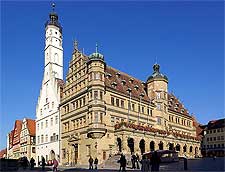Rothenburg ob der Tauber History Facts and Timeline
(Rothenburg ob der Tauber, Bavaria, Germany)

Today, Rothenburg is one of the most beautifully preserved towns in Germany. Yet in the Middle Ages period of history, it was actually the second-largest city in the country. Its position above the Tauber River gave it its name - Rothenburg ob der Tauber.
The first recorded signs of settlement here date back to 950 AD. We also know that in the late 11th century, the first castle was built here, while a second castle was constructed in 1142. In 1172, Frederic I of Hohenstaufen granted civic rights to Rothenburg. The old town comprised of a town hall, market place and church. Its defences took advantage of the natural barrier of a steep cliff. In 1208, the town expanded beyond its original walls.
An Imperial City
In May 1274, King Rudolf of Habsburg granted the town the right to be a Free Imperial City. Such status brought considerable political power to Rothenburg. It also fostered economic success. Practically an independent state, Rothenburg had its own currency and the right to self-government. By the end of the 14th century, some 6,000 people lived here.

Three fairs were held in the city each year and it became a popular place for pilgrimage. These were its 'glory days' in history, although there were occasional setbacks that included plague outbreaks and an earthquake. The latter destroyed part of the city in 1356. By now, construction of one of the city's best-known landmarks - St. Jakob's Church, was well underway. It was followed in 1388 by Toppler Castle, a tiny towered building that was the creation of Lord Mayor Heinrich Toppler.
During the Reformation, Rothenburg chose to become Lutheran, thus avoiding much of the religious turmoil that beset many European cities at that time. In the Thirty Years' War of the early 17th century, the town was invaded by troops led by the imperial general, Count Tilly.

History From the 19th Century
In the early years of the 19th century, as a consequence of the Napoleonic Wars, Rothenburg ob der Tauber lost its independent status. It declined into a mostly forgotten provincial backwater.
Then, in 1865, a social theorist called Wilhelm Heinrich Riehl is said to have 'discovered' Rothenburg ob der Tauber, and the town was subsequently featured in several magazines. After unification, it became something of a national icon, since it represented Germany's romantic past. In the late 1800s, the town's fortunes revived further. The medieval charms of the town attracted a number of artists, who were interested in painting its many historic buildings.

Damage During the Second World War
During World War Two, the town suffered heavy bomb damage. Almost half of the town's buildings were destroyed and several hundred metres of its medieval wall was left in ruins. During the post-war period, the town's attention quickly shifted to its reconstruction. Just a few months after the cessation of the war, Rothenburg was already considering how best to go about rebuilding the town, so as to ensure that it retained its traditional character.
In 1974, the first Imperial City Festival was held here and continues to be staged every year. Today, Rothenburg ob der Tauber has become one of Germany's most popular tourist destinations. Its quaint medieval architecture and walled fortifications attract over two and a half million visitors every year.
 Today, Rothenburg is one of the most beautifully preserved towns in Germany. Yet in the Middle Ages period of history, it was actually the second-largest city in the country. Its position above the Tauber River gave it its name - Rothenburg ob der Tauber.
Today, Rothenburg is one of the most beautifully preserved towns in Germany. Yet in the Middle Ages period of history, it was actually the second-largest city in the country. Its position above the Tauber River gave it its name - Rothenburg ob der Tauber. Three fairs were held in the city each year and it became a popular place for pilgrimage. These were its 'glory days' in history, although there were occasional setbacks that included plague outbreaks and an earthquake. The latter destroyed part of the city in 1356. By now, construction of one of the city's best-known landmarks - St. Jakob's Church, was well underway. It was followed in 1388 by Toppler Castle, a tiny towered building that was the creation of Lord Mayor Heinrich Toppler.
Three fairs were held in the city each year and it became a popular place for pilgrimage. These were its 'glory days' in history, although there were occasional setbacks that included plague outbreaks and an earthquake. The latter destroyed part of the city in 1356. By now, construction of one of the city's best-known landmarks - St. Jakob's Church, was well underway. It was followed in 1388 by Toppler Castle, a tiny towered building that was the creation of Lord Mayor Heinrich Toppler.
